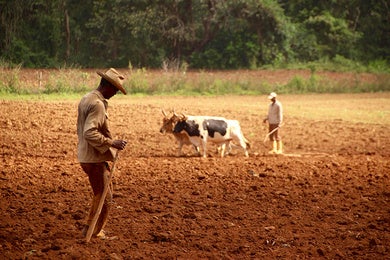
How can we at IDB Invest support the structuring of Public-Private Partnerships?
The lack of tax revenues to develop infrastructure in Latin America and the Caribbean has given rise to public-private partnerships (PPPs) as an option for developing strategic infrastructure projects. In this context, IDB Invest is prepared to support countries in the region.

Pushing boundaries with blended finance in Latin America and the Caribbean
Every transition, every turning point, moves through critical junctures wherein a slight push determines the success or failure of a transformative proposal. Crossing the frontiers or staying in the same place. This applies to everything, from people to new business models or innovative financial solutions.

Financing value chains: A need for speed
The technological revolution has come to stay in finance, bringing with it a transformation in how small and medium enterprises (SMEs) in value chains obtain financing and streamlining relations between anchor companies and their suppliers, customers, and collaborators. How does it work? Imagine a company that manufactures aluminum auto parts in Mexico, the principal anchor between the metal supplier and the customer who buys the finished product. The supplier requests the payment as soon as possible, within 30 days, due to its limited working capital. However, 270 days elapse from the time when the company receives the supplies and produces the parts until the sale of the final product. Clearly the money cycle does not match, and the company must pay for its purchases before producing the parts, making the sale and even charging the customer. Existing market conditions make the situation even more difficult, and the increase in aluminum prices does not allow price adjustments from the company to the customers at the same pace that price metal fluctuates. This means that costs for the company increases more rapidly than the final price of its products. Not only Mexico’s automotive industry suffers from the complexities of the cash flow ratio (between the average period to pay the supplier, process the supplies, and collect from the customer), it is even worse in other industries, such as supermarkets. Moreover, the World Trade Organization says that half of all SME requests for financing are rejected, compared to only 7% of the requests made by multinational companies. Access to appropriate and timely financial services for all actors in the value chain is key to achieving successful results. Not only large companies, large producers and traders need access to appropriate financial services suited to their money cycles; small producers need them even more for their survival and financial balance. Thus, value chain financing seeks to fill the gaps created in the anchor company-supplier relationship, as well as to mitigate the perceived risks through innovative ways of providing financial services. But what is the relationship with technology? Value chain financing requires trusting and durable relationships among the different actors and financial institutions. Each party involved must know and understand the other. Access to innovative and flexible financial products and services is vital. Financial technology (fintech) companies help to make this happen and ensure that financing is flexible, transparent, reliable, and accessible 24/7. Fintech companies are a bridge between the anchor company’s requirements and its suppliers and collaborators, through technologies applied to banks’ middle and back offices. By using internet platforms, fintech allow millions of SMEs to access loans, under conditions equal to those enjoyed by larger and more established companies, the missing piece in the puzzle without any doubt. Most financial innovation companies in Latin America and the Caribbean have arisen in the region’s largest markets, including Brazil, Mexico, Colombia, Argentina and Chile. Alliances between fintech companies and financial institutions have been key to bringing promising solutions to scale. But it is not simple. IDB Invest is an essential part of the value chain financing circuit in the region, through strategic alliances with its clients (the region’s large anchor companies) and fintech firms. These alliances allow IDB Invest to support the base of the pyramid in Latin America efficiently. The first step was taken in Mexico, where a framework contract was signed with the fintech eFactor, a Mexican company that offers electronic factoring services for the discount of credit rights derived from the demand for goods and services by large buyers. This marks an important milestone for IDB Invest in its value chain financing transactions and in the creation of scalable and efficient solutions. You can also see more on the impact of the fintech revolution in Latin America and the Caribbean in this full report. Subscribe to receive more content like this! [mc4wp_form]

Why is social inclusion good for agribusiness?
By 2050, a 60% increase of food production will be required, with only a 12% increase in arable land. Considering the social and demographic implications for agricultural producers, finding solutions to include them in production chains is a must. Latin America and the Caribbean region is the largest net exporter of food worldwide. Furthermore, the region has a third of the global fresh water resources, more than a fourth of high-to-medium potential production lands, and around 40% of biodiversity. However, the region has 14 million small-scale family farming, in vulnerable situation, who occupy 80% of the farms, produce 35% of lands, and provide between 40% and 50% of food, according to the study “The Next Global Breadbasket: How Latin America can Feed the World”. Gaps among agricultural producers Whether to raise cattle in Paraguay, grow coffee in Colombia or soy in Brazil, all kinds of agricultural producers are involved in the process, from large businesses to small producers and smallholders, including cooperatives. Although there are also intermediary actors, like in Argentina or Uruguay where larger scales are achieved by leasing lands. This is an already proven business model where the producers are not necessarily land owners. However, among these different types of producers there are gaps that are increasingly evident in terms of scale, access to financing and markets, and technology application. This issue is even more evident among small producers: only 5% has access to formal borrowing, and the continuous fragmentation of land ownership due to the inheritance factor (many times resulting in flawed titles) works against them when trying to achieve minimum scales. The key factor of this gap arises from the climate change effects (which is more evident in Central America due to the narrow distance between both oceans) that, together with scarce and expensive financing, price volatility, increasingly sophisticated technological advances, and climate insurance limitations, impact family farms income. As result, younger generations choose to migrate to large urban centers instead of continuing working in family farms, and thus an important social structure of rural communities keeps on deteriorating. In Mexico alone, the number of people living in rural areas decreased from 57% in 1950 to 29% in 1990, and 22% in 2010, according to the Instituto Nacional de Estadística y Geografía de México (Inegui). David and Goliath’s tale Meanwhile, the consolidation of producers could help the so-called “new generation of cooperatives” and other association forms to achieve larger production volumes to leverage their negotiation power. Along these lines, geopolitics and the global struggle to supply commodities continue being strategic for certain countries, and could become an opportunity for producers. The entry of the Chinese company, COFCO, after acquiring Nidera and Noble Agri, or the purchase of Agro Amazonia in Brazil by the Japanese Sumitomo Corp., are proof of this situation. While on the other side of the chain, if the regulating entities approve the mergers of Bayer-Monsanto, Dow-Dupont, and Syngenta-Chemchina, these companies would control 60% of the seed/biotechnology business, and 70% of the agrochemical industry. How to promote inclusion in production chains So, what can be done to promote inclusion in production chains? While some companies focus their acquisition strategies to purchase commodities from large-scale producers, other companies seek to develop their smaller clients, not only driven by a more social approach, but also because according to FAO, they have a productivity growth potential of 30% to 50% in sugar cane, dairy, and cattle production. To close the productivity gap, a likely and sustainable solution for small producers is long-term financing, provided by investment banking —through trust funds or similar vehicles—, in association with anchor businesses assuming part of the risk and supporting them with technical assistance programs. An example of this trend is the structured financing implemented by IDB Invest (formerly known as Inter-American Investment Corporation) and the International Finance Corporation (IFC), together with ECOM —a global coffee business— and Starbucks for coffee producers that have been affected by rust disease in Nicaragua. This article was originally published at the Huffington Post. Subscribe to receive more content like this! [mc4wp_form]